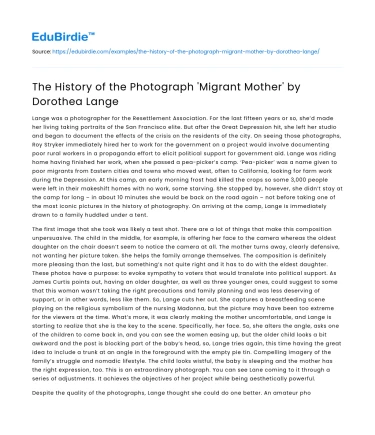Lange was a photographer for the Resettlement Association. For the last fifteen years or so, she’d made her living taking portraits of the San Francisco elite. But after the Great Depression hit, she left her studio and began to document the effects of the crisis on the residents of the city. On seeing those photographs, Roy Stryker immediately hired her to work for the government on a project would involve documenting poor rural workers in a propaganda effort to elicit political support for government aid. Lange was riding home having finished her work, when she passed a pea-picker’s camp. ‘Pea-picker’ was a name given to poor migrants from Eastern cities and towns who moved west, often to California, looking for farm work during the Depression. At this camp, an early morning frost had killed the crops so some 3,000 people were left in their makeshift homes with no work, some starving. She stopped by, however, she didn’t stay at the camp for long – in about 10 minutes she would be back on the road again – not before taking one of the most iconic pictures in the history of photography. On arriving at the camp, Lange is immediately drawn to a family huddled under a tent.
The first image that she took was likely a test shot. There are a lot of things that make this composition unpersuasive. The child in the middle, for example, is offering her face to the camera whereas the oldest daughter on the chair doesn’t seem to notice the camera at all. The mother turns away, clearly defensive, not wanting her picture taken. She helps the family arrange themselves. The composition is definitely more pleasing than the last, but something’s not quite right and it has to do with the eldest daughter. These photos have a purpose: to evoke sympathy to voters that would translate into political support. As James Curtis points out, having an older daughter, as well as three younger ones, could suggest to some that this woman wasn’t taking the right precautions and family planning and was less deserving of support, or in other words, less like them. So, Lange cuts her out. She captures a breastfeeding scene playing on the religious symbolism of the nursing Madonna, but the picture may have been too extreme for the viewers at the time. What’s more, it was clearly making the mother uncomfortable, and Lange is starting to realize that she is the key to the scene. Specifically, her face. So, she alters the angle, asks one of the children to come back in, and you can see the women easing up, but the older child looks a bit awkward and the post is blocking part of the baby’s head, so, Lange tries again, this time having the great idea to include a trunk at an angle in the foreground with the empty pie tin. Compelling imagery of the family’s struggle and nomadic lifestyle. The child looks wistful, the baby is sleeping and the mother has the right expression, too. This is an extraordinary photograph. You can see Lane coming to it through a series of adjustments. It achieves the objectives of her project while being aesthetically powerful.
Save your time!
We can take care of your essay
- Proper editing and formatting
- Free revision, title page, and bibliography
- Flexible prices and money-back guarantee
Despite the quality of the photographs, Lange thought she could do one better. An amateur photographer would have milked the child’s face for their sympathetic potential. Lange even tried to do that herself, but she already knows exactly what the focus needs to be. The daughters’ faces turned behind her mother’s shoulders communicates that message of family – a family of the right size without taking away from the central face, or the eyes, which seem at last to let down their guard as they search the distance in worry. The face is so important that Lange has the women put her hand on her chin so that her arm points to it. It’s a technique that she’s used before. Anything that took attention away from the face would hurt the power of the image, which also explains why Lange had darkroom assistant remove the women’s other thumb where she was holding the post so that she could keep her other hand to her chin. All this manipulation, of course, speaks to the fact that there is very little spontaneous in this iconic image of so called ‘documentary photography’. It’s supposed to communicate candid truth about the moment, but this is anything but candid. Whether that diminishes its power is in the question.
After it was published in San Francisco newspaper, the government sent 20,000 pounds of food to the migrant camp at Nipomo. Stryker fell in love with it and sent it all across the country, after which it came to define the Great Depression in the American consciousness, and on a deeper level, it became the model image of struggling families in any era.
'Migrant Mother' is very expressive, aesthetically pleasing photograph throughout its entire history, but it isn’t until the end where you realize just how carefully how each photography elements have stacked up just to be knocked it all back down in an emotional explosion and that is when they hit you with something only the best photograph can ever offer - a message.






 Stuck on your essay?
Stuck on your essay?

